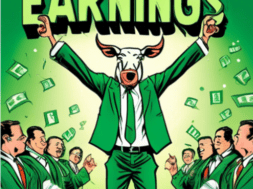Demystifying Volatility: Why Traders Fear It and Why They Shouldn’t
Table of Contents
The Fear Factor
A trader recently brought up this article to the team during a live trading room session. It was thematically relevant: An article on scary volatility during a time where fear is penetrating the markets due to rate hike fears, geopolitical instability, a hot economy and god knows what else lurking around the corner. To our newbie trader’s surprise we got a good laugh out of it.
I’m sure you may be wondering like he is: What’s so funny about trader’s fear? The markets can be a dangerous and unpredictable place. The wonderous tech rally of 2023 was a product of confidence, one that can be dissolved away along with the gains it produced. It left our fledgling friend confused when he saw that the experienced hunters of Turbo Option Trading were practically foaming at the mouth when hearing about incoming volatility.
Volatility in the financial markets is often perceived as the boogeyman by traders. It’s the unseen force that can wreak havoc on portfolios, induce sleepless nights, and trigger knee-jerk reactions. But why exactly do traders fear volatility?
At its core, volatility represents uncertainty. Traders thrive on predictability and patterns, but volatility disrupts this comfort zone. Sudden price swings, unexpected market movements, and rapid shifts in sentiment can leave traders feeling vulnerable and exposed.
Loss Aversion
Psychologically, humans are wired to avoid losses more than they seek gains. Volatility amplifies the potential for losses, triggering a primal fear of financial ruin. This fear of losing hard-earned capital often leads traders to adopt defensive strategies or even exit the market altogether during turbulent times.
Amplified Risk
Volatility is synonymous with risk in the trading world. Higher volatility implies larger price fluctuations, which in turn increases the potential for significant losses. Traders fear being caught on the wrong side of a volatile market, facing losses that far exceed their initial expectations.
The Emotional Rollercoaster
The constant ups and downs of volatile markets can take a toll on traders’ emotions. Fear, greed, and anxiety become amplified, clouding judgment and leading to irrational decision-making. It’s this emotional rollercoaster that many traders find unbearable, driving them to seek safety in more stable environments.
Why Volatility Shouldn’t Be Feared
While volatility may evoke fear in many traders, it’s essential to recognize that it’s not inherently negative. In fact, volatility presents numerous opportunities for savvy traders willing to embrace it. The dynamic invokes a classic scene in Game Of Thrones where the series schemers Littlefinger and Varys discuss the pros and cons of volatility chaos.
Within Turbo Option Trading’s education journey one thing is made clear. It is within volatility where money is made.
Volatility = Opportunity
Contrary to popular belief, volatility creates trading opportunities. Price swings provide the potential for profit, allowing traders to capitalize on short-term fluctuations and market inefficiencies. For skilled traders, volatility is not a threat but a chance. If you know a big move is coming and hedge correctly then you can make money as long as your prediction of the move happening comes true, regardless of it’s direction. It is in the big movements and volatility that fortunes can be won or lost.
Adaptability is Key
Successful traders understand that adaptation is essential in volatile markets. Instead of fearing volatility, they embrace it as an opportunity to refine their strategies and hone their skills. By staying nimble and flexible, traders can navigate turbulent waters with confidence and resilience.
Volatility is a short-term phenomenon that often smooths out over time. While sharp price movements may be unsettling in the moment, they are often temporary and can create attractive entry points for long-term investors. By maintaining a long-term perspective, traders can capitalize on the inherent stability of the markets amidst short-term fluctuations.
Now that we’ve debunked the myth of volatility as the trader’s arch-nemesis, let’s explore some strategies for thriving in volatile markets.
Risk Management
Effective risk management is paramount in volatile markets. Traders should employ strategies such as stop-loss orders, position sizing, and portfolio diversification to mitigate the impact of adverse price movements. By limiting downside risk, traders can preserve capital and withstand market volatility more effectively.
Tactical Trading
In volatile markets, timing is everything. Tactical traders capitalize on short-term opportunities by adapting their strategies to prevailing market conditions. Whether it’s scalping quick profits or swing trading volatile trends, tactical traders thrive on the dynamic nature of volatile markets.
Option Trading
Options provide a powerful tool for managing risk and profiting from volatility. Option strategies such as straddles, strangles, and iron condors allow traders to profit from both upward and downward price movements while limiting downside risk. By leveraging the unique properties of options, traders can navigate volatile markets with precision and confidence.
Fundamental Analysis
While technical analysis is a popular tool for navigating volatile markets, fundamental analysis should not be overlooked. Understanding the underlying drivers of market volatility, such as economic indicators, corporate actions and geopolitical events can be a game changer. This perspective provides valuable insights into market dynamics. By combining technical and fundamental analysis, traders can make more informed decisions in volatile environments.
Embracing Volatility: A Mindset Shift
Ultimately, the key to overcoming the fear of volatility lies in a mindset shift. Instead of viewing volatility as a threat, traders should embrace it as an opportunity for growth and innovation. By adopting a proactive mindset and leveraging the tools and strategies available, traders can navigate volatile markets with confidence and achieve long-term success.
In conclusion, volatility is not something to be feared but embraced. By understanding the underlying causes of market volatility, dispelling common myths, and employing effective strategies, traders can thrive in even the most turbulent market conditions. So, let go of fear, embrace volatility, and unlock the boundless opportunities it presents.





